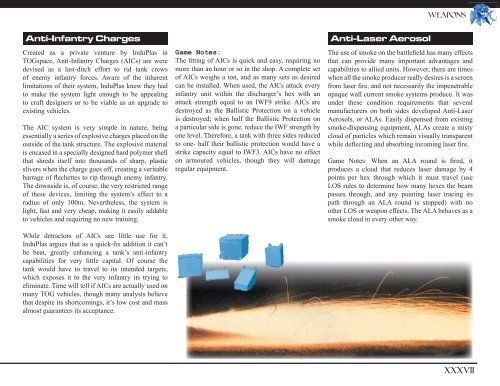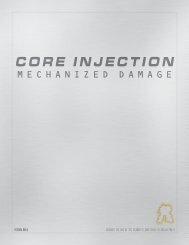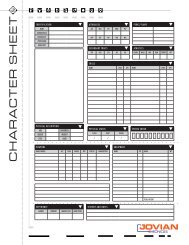renegadelegionneveren dingoffensive - Catsden.net
renegadelegionneveren dingoffensive - Catsden.net
renegadelegionneveren dingoffensive - Catsden.net
You also want an ePaper? Increase the reach of your titles
YUMPU automatically turns print PDFs into web optimized ePapers that Google loves.
WEAPONS<br />
Anti-Infantry Charges<br />
Created as a private venture by InduPlas in<br />
TOGspace, Anti-Infantry Charges (AICs) are were<br />
devised as a last-ditch effort to rid tank crews<br />
of enemy infantry forces. Aware of the inherent<br />
limitations of their system, InduPlas knew they had<br />
to make the system light enough to be appealing<br />
to craft designers or to be viable as an upgrade to<br />
existing vehicles.<br />
The AIC system is very simple in nature, being<br />
essentially a series of explosive charges placed on the<br />
outside of the tank structure. The explosive material<br />
is encased in a specially designed hard polymer shell<br />
that shreds itself into thousands of sharp, plastic<br />
slivers when the charge goes off, creating a veritable<br />
barrage of flechettes to rip through enemy infantry.<br />
The downside is, of course, the very restricted range<br />
of these devices, limiting the system’s effect to a<br />
radius of only 100m. Nevertheless, the system is<br />
light, fast and very cheap, making it easily addable<br />
to vehicles and requiring no new training.<br />
While detractors of AICs see little use for it,<br />
InduPlas argues that as a quick-fix addition it can’t<br />
be beat, greatly enhancing a tank’s anti-infantry<br />
capabilities for very little capital. Of course the<br />
tank would have to travel to its intended targets,<br />
which exposes it to the very infantry its trying to<br />
eliminate. Time will tell if AICs are actually used on<br />
many TOG vehicles, though many analysts believe<br />
that despite its shortcomings, it’s low cost and mass<br />
almost guarantees its acceptance.<br />
Game Notes:<br />
The fitting of AICs is quick and easy, requiring no<br />
more than an hour or so in the shop. A complete set<br />
of AICs weighs a ton, and as many sets as desired<br />
can be installed. When used, the AICs attack every<br />
infantry unit within the discharger’s hex with an<br />
attack strength equal to an IWF9 strike. AICs are<br />
destroyed as the Ballistic Protection on a vehicle<br />
is destroyed; when half the Ballistic Protection on<br />
a particular side is gone, reduce the IWF strength by<br />
one level. Therefore, a tank with three sides reduced<br />
to one- half their ballistic protection would have a<br />
strike capacity equal to IWF3. AICs have no effect<br />
on armoured vehicles, though they will damage<br />
regular equipment.<br />
Anti-Laser Aerosol<br />
The use of smoke on the battlefield has many effects<br />
that can provide many important advantages and<br />
capabilities to allied units. However, there are times<br />
when all the smoke producer really desires is a screen<br />
from laser fire, and not necessarily the impe<strong>net</strong>rable<br />
opaque wall current smoke systems produce. It was<br />
under these condition requirements that several<br />
manufacturers on both sides developed Anti-Laser<br />
Aerosols, or ALAs. Easily dispensed from existing<br />
smoke-dispensing equipment, ALAs create a misty<br />
cloud of particles which remain visually transparent<br />
while deflecting and absorbing incoming laser fire.<br />
Game Notes: When an ALA round is fired, it<br />
produces a cloud that reduces laser damage by 4<br />
points per hex through which it must travel (use<br />
LOS rules to determine how many hexes the beam<br />
passes through, and any painting laser tracing its<br />
path through an ALA round is stopped) with no<br />
other LOS or weapon effects. The ALA behaves as a<br />
smoke cloud in every other way.<br />
XXXVII





